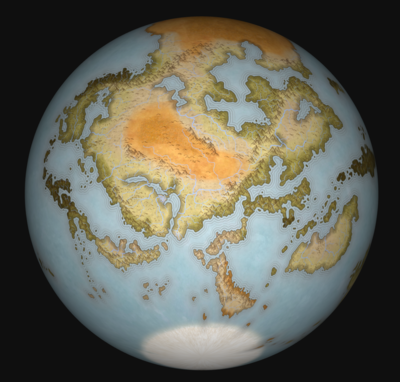Didome is part of a Binary star system with 4 planets (
Yormin,
Lok ,
Didome, and
Parous) orbiting the bright primary star. The drastically dimmer secondary star
Lok's Palace, has two planets in orbit (
Roos and
Cerber).

Planet of Didome by Cory Brooke-deBock
The planet Didome is locked in a 3:2 orbital resonance pattern, meaning that for every three times Didome rotates on its axis it orbits
Novus twice. Didome completly roates on its axis every 61.4 Earth days, and it orbits the sun once every 92.2 days. Due to this resonance pattern, Didome's day is equal to 2 complete orbits (194.4 Earth days). Another way to phrase this is that from the perspective of someone on Didome's surface they would have a day year (92.2 days) and then a night year (92.2 days). Although most inhabitants of Didome would just think of a full day on Didome lasting a very long time (comparable to 1/2 an Earth year if the inhabitants knew what the Earth was).
Didome is an Earth like planet but slightly smaller in size and therefore with less gravity (6.44 m/s^2). The low gravity means that people can carry 50% more mass and not feel that much more encumbered. The atmosphere is about 50% denser at sea level (1.8 kg/m^3). The denser atmosphere means that wind can more easily damage structure and plants. Additionally, the denser atmosphere also means that the effects of altitude sickness don't start until one is at a higher elevation.
The the 3:2 orbital resonance pattern and denser atmosphere of Didome give it an interesting climatic pattern. With
Novus taking 92.2 Earth days to cross the sky, half of the planet is very hot and humid, while the night side remains frigid. However, the dense atmosphere on the planet constantly draws the frigid night air to the hot noontime. Warming up the air and creating storms that rush torords the noon of the planet. The hot stormy air then is forced up and back to the night side warming it up. This pattern of air flow means that both sides of the planet remain at temperatures habitable for humans. The night side might reach temperatures of around -30 C and the day side might reach temperature close to 37 C.

Tidal Dynamics at Jehovi
Didome also experiences complex tidal dynamics from three different sources:
Novus,
Ides, and
Ock. The
Great Tide is caused by
Novus and has 46 Earth days between high and low tides. The typical tidal range for the tide is around 5 meters. The
Ides Tide is caused by the moon
Ides, and there is about 31.5 hours between high and low tide. The typical tidal range of the Ides tide is about 3.5 meters. This means that a typical ides tide comes in about half as quickly as a typical Earth tide. The last tide is the
Ock Tide, and it has a time of about 4 Earth hours between high and low tides. The typical tidal range is about 0.9 meters.




Comments